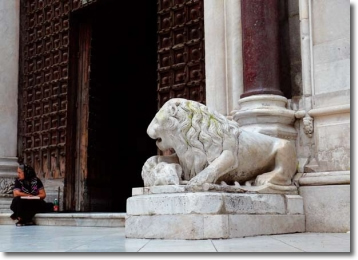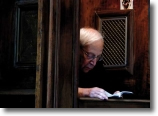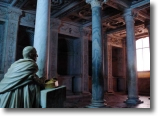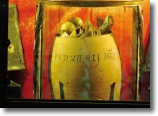Warning! The template for this page [TurismoCultura.html] doesn't exists.
Cathedral

In the middle of Via Duomo it rises the Cathedral of Naples, devoted to the Assumption of the Holy Virgin. This place was, first of all, the heart and the center of pagan worship, and then the cradle of Christian faith in Naples. When Naples was chosen as the capital, during the Kingdom of the dynasty of Anjou, King Charles I began the construction and the foundation of the new cathedral of Naples, destroying many monuments of the old Stefania...The Cathedral has been rehandled frequently during the centuries: in the seventeenth century the Cardinal Decio Carafa modernized the pointed arch of windows; afterwards the Cardinal Innico Caracciolo dressed the walls with plasters in baroque style and ordered that the marble columns were covered with plaster as well.
In the eighteenth century the Cardinal Giuseppe Spinelli rearranged the tribune and placed there the high altar, that was in the middle of cross. [In the nineteenth century] the Cardinal Filippo Caracciolo brought the cathedral to existing [current] appearance removing the plasters of with which were covered the columns; the repair was completed by the Cardinal Sisto Riario Sforza [in the 1871 he completely reconstructed the tribune. In the 2 twentieth century were made many restorations and works of liturgical arrangements. The façade was made by Enrico Alvino, it was completed in 1898 and inaugurated in 1905.].
The inside of the church is divided in a nave and two side aisles, in a perfect Latin cross shape; 14 pillars supporting the nave's arches and two greater pillars supporting the principal arch. Each pillar is embellished with three columns of oriental granite or other African marble; the two greater pillars have five columns...
Draw up even an approximate list of the masterpieces contained in the chapels of the cathedral take up much space of this work, but at least it's important to remember some of the masters who worked in these chapels: sculptures were made by Tino da Caimano, Paolo de Matteis, Giuseppe Sammartino, Nicola Vaccaro, Nicola Maria Rossi, Bartolomè Ordonez, Lello da Orvieto and Giulio Mecaglia; in the Capece Minutolo's Chapel (a beautiful example of Neapolitan gothic) there are sculptures of Domenico Antonio Vaccaro and in the Brancaccio's Chapel, projected by Giovanni Antonio Dosio, sculptures were made by Pietro Bernini, Girolamo D'Auria, Michelangelo Naccherino, Tommaso Montani and the paintings were made by Francesco Curia; the altarpiece of the Assumption of the Holy Virgin, painted by Pietro Vannucci, also known as "il Perugino" (teacher of Raffaello Sanzio) in 1506.
The Succorpo (or Succorpo Chapel) represents a perfect example of architecture of renaissance
style, realized by the lombard sculptor Tommaso Malvito, influenced by Bramante. The chapel is situated under the apse, it's divided in three naves with murbles columns: in the center there's a sculpture represented Oliviero Carafa. A recent restoration has allowed the recovery of the coffered marble ceiling of the sixteenth century. Under the altar, in an earthenware pot, are preserved the bones of St. Gennaro.
Inside the Cathedral, on the left aisle, there is the entrance to the basilica of Saint Restituta, It represents a testimony of the early christian art: built in the IV century, was restored in the present form in the late eighteenth century; from the Basilica there is the access to baptistery of St. Giovanni in Fonte, the most ancient baptistery of Europe.



